THE VILLAGE TIMES
Independence Village of Olde Raleigh Resident Newsletter



Meet Mabel Boerger
by Pat Simpson
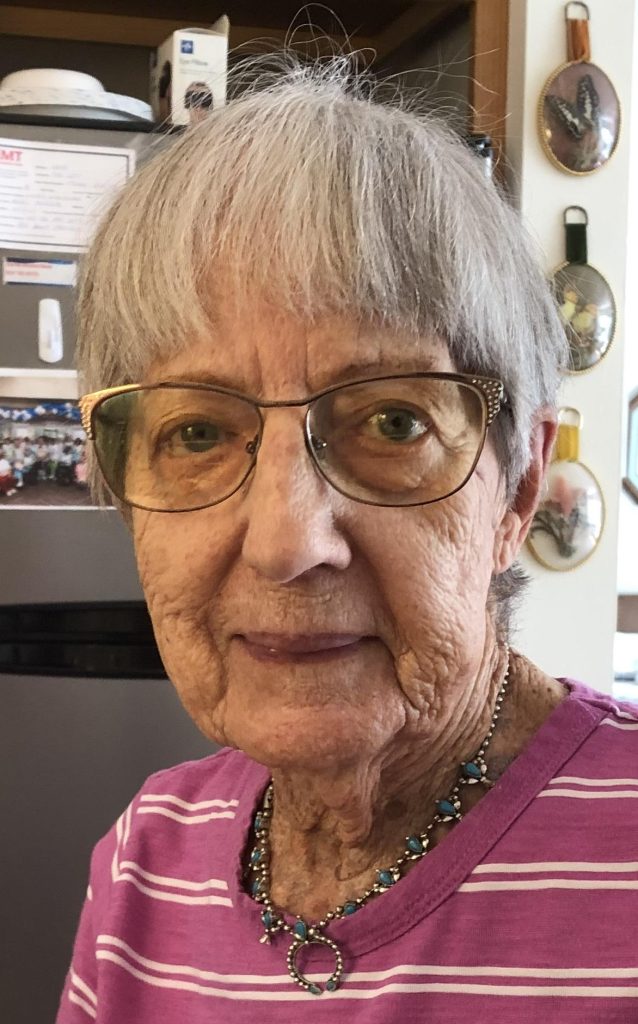 Hello everyone! My name is Mabel Boerger and I’ve lived here less than a year. In 1925 I was born in Marysville Ohio, a town of ±25,000 folks located about 27 miles northwest of Columbus. The town slogan is “Where the Grass is Greener”. My childhood friends and I thought our neighbor’s Granny Smith apples were greener as well – as we raided their apple orchard each summer.
Hello everyone! My name is Mabel Boerger and I’ve lived here less than a year. In 1925 I was born in Marysville Ohio, a town of ±25,000 folks located about 27 miles northwest of Columbus. The town slogan is “Where the Grass is Greener”. My childhood friends and I thought our neighbor’s Granny Smith apples were greener as well – as we raided their apple orchard each summer.
You may have heard of Marysville: it’s the home of O.M. Scott & Sons Company, famous for shipping lawn grass seed to homeowners through the mail. Not to be outdone, Honda also established a foothold there, building motorcycles in its Marysville Motorcycle Plant for over 30 years (1979-2009). Likewise, the Honda Marysville Auto Plant opened in 1982 and currently produces vehicles such as the Honda Accord, the Acura TLX and the Acura Integra.
Although I lived in Marysville I went to school in nearby Broadway, Ohio, where I graduated from high school. Then I went to work in a local bar – for nine years. It was during that time, during a card game, that I fell in love with John Boerger, a man only three years older than I. We got married on April 30, 1950. Ultimately, we were blessed with my wonderful daughter Roberta, who lives in Raleigh. Sadly, John passed away over twenty years ago.
 John had a bad case of arthritis so we decided to move to Arizona where the
John had a bad case of arthritis so we decided to move to Arizona where the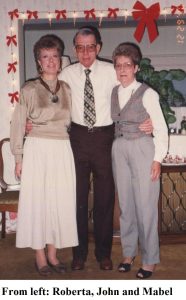 climate was great and there were doctors aplenty. At length I applied for a job as typist on the Tucson police force in Arizona. For over 6.5 years I typed up testimonies from suspects for the police. Then I worked for nine more years typing up judges’ decisions for the same police force. For all that typing I used old-fashioned manual typewriters. (Today we call them vintage typewriters.)
climate was great and there were doctors aplenty. At length I applied for a job as typist on the Tucson police force in Arizona. For over 6.5 years I typed up testimonies from suspects for the police. Then I worked for nine more years typing up judges’ decisions for the same police force. For all that typing I used old-fashioned manual typewriters. (Today we call them vintage typewriters.)
I finally decided to change jobs and went to work at the Sears Insurance Company. Two years later I changed employers again and worked for the Hartford Insurance Company.
John worked as a postmaster over the years so we frequently changed locations, buying three homes during career moves. But life for John (and me) changed drastically one day when he was severely and permanently injured. An 18-year-old ran a red light and crashed into his car, changing his life forever. John never complained about his injuries, even though he always had to have a nurse afterwards. Our bills came to over $300,000 of which the post office paid some but not all of it. Eventually John went back to work, this time as a postmaster in Mount Lemmon (aka Summerhaven), Arizona, a little town atop the same-named mountain, just north of big-city Tucson, Arizona. Although it’s an isolated little town, Mount Lemmon has multiple attractions such as a ski resort and the Cookie Cabin – drawing tourists from all over Arizona and the world. But there were so few permanent townsfolk that the entire village turned out to celebrate at John’s retirement party. Getting up in years, we decided to move back down the mountain to Tucson in a residential area known as Hampton Place.
From there we could still see Mount Lemmon. After all, the summit of Mount Lemmon – at 9,159 feet –the highest point of the Santa Catalina Mountains. We loved everything about Mount Lemmon.
In 2003, “our” Mount Lemmon caught fire in what became known as the Aspen fire. It started on June 17, 2003 and lasted until July 12, 2003. Authorities deemed it was human caused. In the month-long burn, about 340 homes and businesses as well as 84,750 acres of land were destroyed. A combination of drought, high winds, and lack of water allowed the fire to burn for 26 days. The severe fire left trees completely scorched,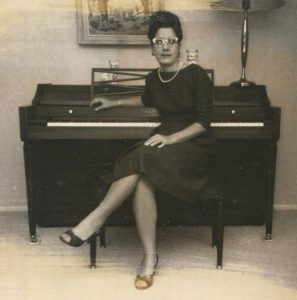 and the underbrush and younger trees turned to ash. Although our little cabin was spared, the Aspen Fire left a lasting mark. Over twenty years later, the scars are still visible.
and the underbrush and younger trees turned to ash. Although our little cabin was spared, the Aspen Fire left a lasting mark. Over twenty years later, the scars are still visible.
Unlike my childhood friends I wanted to be an undertaker when I grew up. But how do you bury a mountain?
However, Mount Lemmon is still “alive”. As for me, I live in Independence Village of “Olde Raleigh” and my daughter Roberta lives in Fuquay-Varina, where she deals with her husband’s cancer. By the way, I think she is my life’s greatest accomplishment and don’t mind saying so.
I like to shop, but I am best known for playing the organ. I used to bring joy to residents of nursing homes and places like this by playing their old favorites on whatever organ or piano was handy.

Editor’s note: The last time I saw my mother (Alma Ready) was at the Carondelet Holy Cross Hospital in Nogales, Arizona. She was 95 and had been an Alzheimer’s patient for several months. Needless to say, she had slowed down considerably. Late one night, May 29, 2003, I got the inevitable phone call from the hospital. Mom had died in her sleep. Pneumonia.
The service was indeed held on June 21. My wife and I flew from Raleigh to Phoenix, and then drove south 180 miles by rental car to Nogales via Tucson. From start to finish we could see plumes of smoke spewing from the lofty forests of Tucson’s Mount Lemmon. People were calling it “the Aspen Fire” and from a distance it looked like a volcano eruption. The out-of-control flames had already destroyed over 200 homes.
– By Pat Simpson
WHERE HAVE ALL THE GRANDMA’S GONE? –submitted by Joby Gilbert
In the dim and distant past
When life’s tempo wasn’t so fast,
Grandma used to rock and knit,
Crochet, tat and baby sit.
When the kids were in a jam,
They could always call on Gram.
But today she’s in the gym
Exercising to keep slim.
She’s checking the web or surfing the net,
Sending some e-mail or placing a bet.
Nothing seems to stop or block her,
Now that Grandma’s off her rocker.

A Hog-killing Celebration – by Frank Howes
Christmas week brought the first hard freeze, and Granddaddy sharpened his well-worn butcher knives, dug a pit, and set up the vat for the hog-killing the next day. In the morning, he arose early and lit the fire to heat the water until steam arose into the chill.
The first of six hogs stood dazed after being shot between the eyes. He died only after Ol’ Uncle Ligey stuck him in the neck and hung him by the ham strings to bleed out. The hot blood quickly cooled and congealed into mud. A cloying earthy odor arose from the hog after we placed him in the vat, where we scalded him in preparation for scraping off the hair with Mason jar lids and razor-sharp kitchen knives.
The smelly innards fell from the swinging hog into a galvanized wash tub as Uncle Ligey carefully gutted him. Uncle Ligey explained the various organs, and once 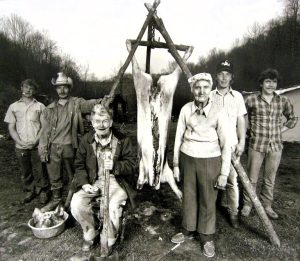 blew into the pig’s lungs to show me how they worked. Local black women did the undesirable work of stripping the guts to make the chitlin’s that they loved so much. They saved some of the chitlin’s for sausage casings.
blew into the pig’s lungs to show me how they worked. Local black women did the undesirable work of stripping the guts to make the chitlin’s that they loved so much. They saved some of the chitlin’s for sausage casings.
After the men cut up the hog, Grandmamma and some of the women prepared the elaborate lunch that we would eat in shifts. Others cut up the pig-fat and skins; we used wooden paddles to stir the frying pieces in big black iron caldrons; then we pressed out the lard to make cracklins. The men split the skull with an ax and saved the contents for a special treat, brains and eggs, the next morning. Granddaddy salted the hams and hung them in the smokehouse.
A celebration of a time of plenty, all the participating neighbors and family received some of the bountiful meat in payment for their help.
Today, the little farms are gone. No one kills hogs anymore. Would anyone even know how? Those days are gone, along with the small tobacco farmer, the big kitchen gardens, and the quail. In my youth, the names in my neighborhood were English, Scotch, and Irish. Then the Italians moved in. Then the Lebanese, Now the names are mostly Hispanic. Have we made progress? Are we better for all our diversity? Are we better off since all profitable farms are now big business?s You tell me. I miss my grandparents. I miss their farm, which soon may not be in the family anymore. I miss the eastern North Carolina I grew up in.
HOW DO I LOVE THEE?
(penned in the King’s English)
by Elizabeth Barrett Browning, 1806
‘enhanced’ by Patrick Duffield Simpson, 2024
How do I love thee? Allow me count the ways.
I love thee to the breadth and depth and height
my soul can reach when feeling out of sight
I love thee in the morrow and I love thee at night.
I love thee and respect thee, that is so clear
and I love thee from a distance as well as so near.
I love thee in the springtime
and I love thee through the year.
There is no other name to bid thee
other than “I love thee dear”.
I long to hark those words so few
from thine heart unto my ear.
It had to get dark ere I could see the stars.
yet when I looked up, there thou were.
shining brightly as the traveling lamp.
Thou brighten up my day my dear,
 Thou art the rainbow after my heaviest storms.
Thou art the rainbow after my heaviest storms.
and thou hast brightened up my life – forever
MEMORIAL DAY PROGRAM
INDEPENDENCE VILLAGE OF OLDE RALEIGH
MAY 27, 2024a
Presented by John “Jack” Sobczak
“THE FLAG WAS STILL THERE”
PLEASE STAND AND FACE THE FLAG – (IF ABLE)
“NATIONAL ANTHEM” – (SING WITH MUSIC – IF DESIRED)
(REMAIN STANDING)
“PLEDGE OF ALLEGIANCE”
(PLEASE BE SEATED)
“WELCOME”
VETERANS AND SPOUSES
WIDOWS OF DECEASED VETERANS
RESIDENTS, STAFF, AND VISITORS
“INTRODUCTION OF RESIDENT VETERANS”
“THE REAL MEANING OF MEMORIAL DAY”
“FOLDING OF THE FLAG”
“I WILL FLY THE FLAG”
“OLD GLORY”
“TAPS”
“POPPIES”
“POW AND MIA CEREMONY”
“PRAYER”
“CLOSING CEREMONY”
“GOD BLESS AMERICA” – (ALL SING WITH TAPED MUSIC – 2ND VERSE)
DISMISSED “STARS AND STRIPES”
FOLDING THE FLAG
The American flag is folded in a certain manner because it adds a dignified touch and is considered respectful. Once folded, the flag is visually appealing and is in a shape that is easy to handle and to store until it is next raised on the flagpole. The origins of the flag folding procedure are unknown
The clarification includes the following:
- Volunteer honor guards are authorized to read the 13-fold flag recitation or any comparable script;
- Survivors of the deceased need to provide material and request it be read by the volunteer honor guards; and
- Volunteer honor guards will accept requests for recitations that reflect any or no religious traditions, on an equal basis.
- Veterans with a discharge other than dishonorable, their spouses and eligible dependent children can be buried in a national cemetery.
- Other burial benefits available for all eligible veterans, regardless of whether they are buried in a national cemetery or a private cemetery, include a burial flag, a Presidential Memorial Certificate, and a government headstone or marker.
MEANING OF FLAG-FOLDING PROGRAM
- The flag-folding ceremony represents the same religious principles on which our great country was originally founded.
- The portion of the flag denoting honor is the canton of blue containing the stars representing states our veterans served in uniform. The canton field of blue dresses from left to right and is inverted only when draped as a pall on the casket of a veteran who has served our country honorably in uniform.
- In the U.S. Armed Forces, at the ceremony of retreat, the flag is lowered, folded in a triangle fold and kept under watch throughout the night as a tribute to our nation’s honored dead. The next morning it is brought out and, at the ceremony of reveille, run aloft as a symbol of our belief in the resurrection of the
WHY THE AMERICAN FLAG IS FOLDED 13 TIMES.
Have you ever noticed on TV or at military funerals that the honor guard pays meticulous attention to correctly folding the American flag 13 times? It is known how the 21-gun salute was determined (adding the individual digits of 1776), but only recently learned why the flag was folded 13 times when it is lowered or when it is folded and handed to the widow at the burial of a veteran.
HERE IT IS:
- The first fold of our flag is a symbol of life.
- The second fold is a symbol of our belief in eternal life.
- The third fold is made in honor and remembrance of the veterans departing our ranks who gave a portion of their lives for the defense of our country to attain peace throughout the world.
- The fourth fold represents our weaker nature, for as American citizens trusting in God, it is to Him we turn in times of peace as well as in time of war for His divine guidance.
- The fifth fold is a tribute to our country, for in the words of Stephen Decatur, “Our Country, in dealing with other countries, may she always be right; but it is still our country, right or wrong.”
- The sixth fold is for where our hearts lie. It is with our heart that we pledge allegiance to the flag of the United States of America, and to the Republic for which it stands, one Nation under God, indivisible, with Liberty and Justice for all.
- The seventh fold is a tribute to our Armed Forces, for it is through the Armed Forces that we protect our country and our flag against all her enemies, whether they be found within or without the boundaries of our republic.
- The eighth fold is a tribute to the one who entered into the valley of the shadow of death, that we might see the light of day, and to honor mother, for whom it flies on Mother’s Day.
- The ninth fold is a tribute to womanhood; for it has been through their faith, their love, loyalty and devotion that the character of the men and women who have made this country great has been molded.
- The tenth fold is a tribute to the father, for he, too, has given his sons and daughters for the defense of our country since they were first born.
- The eleventh fold, in the eyes of a Hebrew citizen, represents the lower portion of the seal of King David and King Solomon, and glorifies in their eyes, the God of Abraham, Isaac, and Jacob.
- The twelfth fold, in the eyes of a Christian citizen, represents an emblem of eternity and glorifies, in their eyes, God the Father, the Son, and the Holy Spirit.
When the flag is completely folded, the stars are uppermost, reminding us of our nation’s motto, “In God We Trust”. After the flag is completely folded and tucked in, it takes on the appearance of a cocked hat, ever reminding us of the soldiers who served under General George Washington, and the sailors and marines who served under Captain John Paul Jones, who were followed by their comrades and shipmates in the Armed Forces of the United States, preserving for us the rights, privileges, and freedoms we enjoy today
THE FLAG WAS STILL THERE
On September the 14, 1814, FRANCIS SCOTT KEY penned the lyrics to a song entitled “Defense of Fort McHenry,’ after witnessing the Maryland fort under attack by the British during the war 1812.
KEY, an attorney, viewed the bombardment from a nearby ship. At daybreak, ne was inspired by the sight of a lone American flag still standing. He wrote, “And the rocket’s red glare, the bombs bursting in air, gave proof through the night that our flag was still there.”
The song gained swift popularity and became known as “The Star-Spangled Banner.” It was officially adopted as the nation’s national anthem on March 3, 1931.
THIS IS THE COMPLETE VERSION OF THE STAR-SPANGLED BANNER from the manuscript in the Maryland Historical Society collection which also shows spelling and punctuation.
“On the shore dimly seen through the mists of the deep, Where the foe’s haughty host in dread silence reposes, What is that which the breeze, o’er the towering steep, As it fitfully blows, half conceals, half discloses? Now it catches the gleam of the morning’s first beam, In full glory reflected now shines in the stream, ‘Tis the star-spangled banner – O long may it wave O’er the land of the free and the home of the brave!
And where is that band who so vauntingly swore, That the havoc of war and the battle’s confusion A home and a Country should leave us no more? Their blood has wash’d out their foul footstep’s pollution. No refuge could save the hireling and slave – From the terror of flight or the gloom of the grave, And the star-spangled banner in triumph doth wave O’er the land of the free and the home of the brave.
O thus be it ever when freemen shall stand, Between their lov’d home and the war’s desolation! Blest with vict’ry and peace may the heav’n rescued land, Praise the power that hath made and preserv’d us a nation! Then conquer we must, when our cause it is just, And this be our motto – “In God is our trust,” And the star-spangled banner in triumph shall wave O’er the land of the free and the home of the brave.”
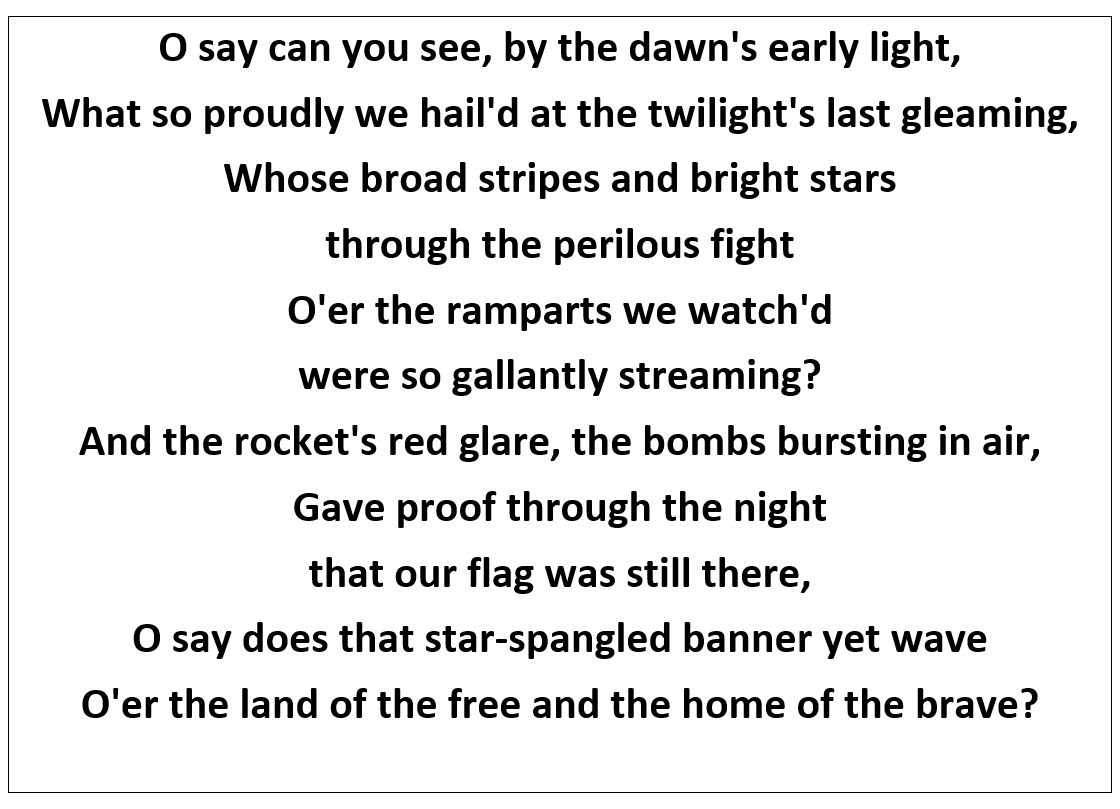
THE IMMORTAL CHAPLAINS
LT GEORGE L. FOX
As a medical corps assistant during World War I, Fox was highly decorated for bravery and awarded the Silver Star, Purple Heart, and The French Croix de Guerre.
Fox studied at Moody Institute, Illinois Wesleyan, and Boston University School of Theology. He and his wife, Isadora, had two children.
Fox went on active-duty August 8, 1942, the same day his son Wyatt enlisted in the Marine Corps. He was assigned to the Chaplains School at Harvard.
THE REAL MEANING OF MEMORIAL DAY
Today we celebrate Memorial Day, which is a federal holiday to honor and mourn all military personnel who died while serving their country. It is a solemn day of remembrance, originally known as Remembrance Day that started shortly after the Civil War to honor both Union and Confederate dead. It should not be confused with Veterans Day which honors those who served in the Armed Forces – nor Armed Forces Day, an unofficial U.S. holiday to honor those currently serving.
While this holiday marks the unofficial start of summer in the U. S., many of us tend to think of it only as a day for family gatherings, backyard barbecues, beach trips and evening fireworks. Some will probably visit national cemeteries and memorials, a few of us really know or appreciate the magnitude of those fallen souls who “gave their last measure of devotion” while serving their country.
Here are some numbers that should give us pause and help us remember the true meaning of Memorial Day:
(Note: Numbers are not provided for those who died after World War II.)
- The total number of men and women who have died in the major conflicts since the American Revolution is over 1.4 million (many from disease, not just combat.
- It is estimated that more than 705,000, died in the American Civil War alone.
- Another 405,000+ in World War II and over 116,000 in World War I.
- These and other war casualties are buried in cemeteries all over the world including some 26 national cemeteries. As you celebrate this Memorial Day, I hope you will think about the sacrifice that has been paid by these noble patriots as the price for our freedom. This is where valor rests.
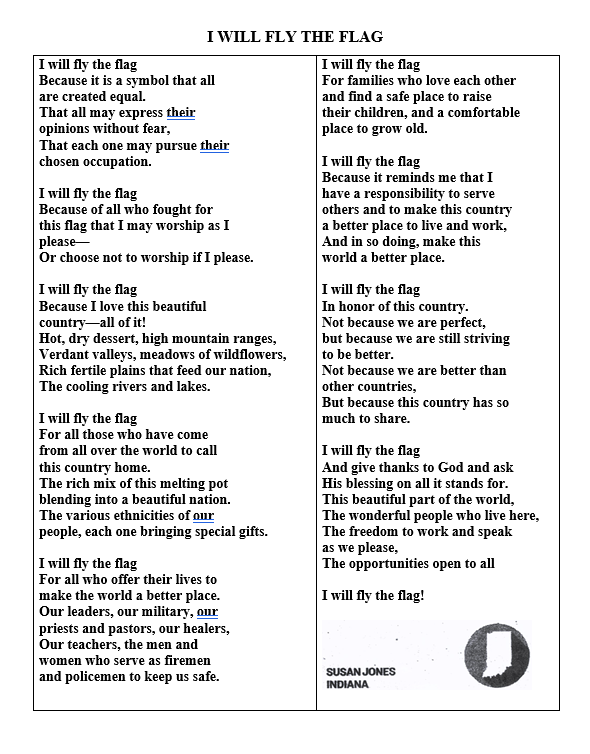
OLD GLORY
I AM THE FLAG OF THE UNITED STATES OF AMERICA.
My name is “OLD GLORY.”
I fly atop the world’s tallest buildings.
I stand watch in America’s halls of justice,
I fly majestically over great institutions of learning,
I stand guard with the greatest military power of the world.
Look up! And see me,
I stand for peace – truth, and justice.
I stand for freedom.
I am confident;
I am arrogant.
I am proud when I am flown with my fellow banners.
My head is a little higher,
My colors a little truer,
I bow to no one!!!
I am recognized all over the world.
I am worshipped – I am saluted – I am respected.
I am revered – I am loved, and I am feared!
I have fought in every battle of every war for more than 200 years:
Gettysburg, Shiloh, Appomattox, San Juan Hill,
the trenches of France, The Argonne Forest, Anzio, Rome,
the beaches of Normandy, Guam, Okinawa, Tarawa, Korea,
Vietnam, the Persian Gulf And a score of places, long
forgotten by all, except by those who were there with me,
I was there!
I led my sailors and marines.
I followed them.
I watched over them.
They loved me!!
I was on a small hill on Iwo Jima.
I was dirty, battle-worn, and tired but my sailors and marines
cheered me,
And I was proud!!!
I was at ground zero in New York City on September 11th
As cowardly fanatics attacked America.
I was raised from the ashes of once-proud buildings by brave
firefighters.
Heroes who risked their lives to save others, showing all
that America,
Although blooded, will never be beaten.
Those who would destroy me cannot win,
For I am the symbol of freedom,
Of one nation under God indivisible
with liberty and justice for all.
I have been soiled, burned, torn, and trampled on the streets
Of my own country, and, when it is by those whom I have
served with,
In battle, it hurts.
But I shall overcome for I am strong!
I have slipped the sure bonds on earth,
And from my vantage point, on the moon,
I stand watch over the uncharted new frontiers of space.
I have been a silent witness
To all of America’s finest hours,
But my finest hour comes when I am torn in strips,
‘to be used as bandages for my wounded
Comrades on the field of battle,
‘when I fly half-mast to honor my soldiers,
And when I lie in the trembling arms of a grieving mother
At the grave site of her fallen son or daughter.
I am proud!!!
My name is “O L D G L O R Y”
Long may I wave dear God.
Long may I wave.
I hope this means the same to you
as it does for us Veterans.
POPPIES
Poppies are important to Veteran‘s Day because of their poignant mention in the WWI poem: “In Flanders” Field”. They are not just important they are a big deal because the red… means the blood of the people that died and the green is for Flanders Field.
The use of the poppy as a symbol on Veterans Day (Remembrance Day in the Commonwealth) is derived from its symbolism in the poem “In Flanders Fields” by John McCrae. These poppies bloomed across some of the worst battlefields of Flanders in World War I, their brilliant red color an appropriate symbol for the blood spilt in the war.
In the years following World War One, governments and society in general had not yet accepted responsibility for those maimed and bereaved as a result of the Great War. Massive unemployment in Britain made the problem much worse.
Earl Haig, the Commander in Chief of the British Army undertook the mighty task of organizing the British Legion as a means of helping with the problems of hundreds and thousands of men who had served under him. In 1921, a group of French widows visited him at the British Legion Headquarters. They had brought with them some poppies they had made, and suggested selling them as a means of raising money.
The most recent and enduring tradition began in WWI when John McCrae wrote this famous poem:
In Flanders Fields
“In Flanders Fields the poppies blow
Between the crosses, row on row
That mark our place; and in the sky
The larks, still bravely singing, fly
Scarce heard amid the guns below.
We are the Dead Short days ago
We lived, felt dawn, saw sunset glow
loved and were loved, and now we lie,
In Flanders Fields.
Take up our quarrel with the foe
To you from failing hands we throw
The torch; be yours to hold it high.
If ye break faith with us who die
We shall not sleep, though poppies grow
In Flanders Fields.”
John McCrae 1915
McCrae was a Canadian who enlisted to help the allies in the war. He was made Medical Officer upon landing in Europe. During a lull in the battle with the nub of a pencil he scratched on a page from his dispatch book. The poem found its way into the pages of Punch magazine. By 1918 the poem was well known throughout the allied world. Moina Michael, an American woman, wrote these lines in reply:
We cherish too, the Poppy red
That grows on fields where valor led,
It seems to signal to the skies
That blood of heroes never dies.
She then adopted the custom of wearing a red poppy in memory of the sacrifices of war and also as a symbol of keeping the faith.
A French woman, Madam Guerin, visiting the United States, learned of the custom and took it one step further. When she returned to France, she decided to hand make the red poppies and sell them to raise money for the benefit of the orphaned and destitute women and children in war torn areas of France. This tradition spread to Canada, the United States and Australia and is still followed today.
The reason for the Poppy is that it is a plant which thrives on disturbed ground. The seeds, which are produced by the millions in the seed heads, lie dormant until the soil is broken up. The shelling in the trenches was perfect for the poppy, which grew in their millions when nothing else did. The poems came later, the poppies came from the activity and the blasting of the ground.
What is the flower from poppy?
A Poppy is a Cactus that is Blue. It has 4 Petals and is tall like a tree. it is also extraordinarily beautiful. Poppies grew wild in the fields in Flanders, where many of the battles of World War 1 took place. They particularly proliferated after the battles were over, the soil churned up, and the area fertilized with the blood of thousands. For this reason, they are a significant link with war veterans. It is fitting that they be sold to raise funds for the veterans of any conflict, or their widows, who need help.
TAPS
The tune is a variation of an earlier bugle call known as the “Scott Tattoo”, which was used in the U.S. from 1835 until 1860 and was arranged in its present form by the Union Army Brigadier General Daniel Butterfield, an American Civil War general and Medal of Honor recipient who commanded the 3rd Brigade of the 1 st Division in the V Army Corps of the Army of the Potomac while at Harrison’s Landing, Virginia, in July 1862 to replace a previous French bugle call used to signal “lights out”. Butterfield’s bugler, Oliver Wilcox Norton, of East Springfield, Pennsylvania, was the first to sound the new call. Within months “Taps” was used by both Union and Confederate forces. It was officially recognized by the United States Army in 1874.
“Taps” concludes many military funerals conducted with honors at Arlington National Cemetery and elsewhere in the United States. The tune is also sounded at many memorial services in Arlington’s Memorial Amphitheater and at grave sites throughout the cemetery. It is also regularly played at the American Cemetery in Normandy, France, to commemorate the sacrifice made, at & around that site, by United States servicemen in WWII, during the allied effort to liberate Europe from the Nazis.
Captain John Francis Tidball, West Point Class of 1848, started the custom of playing “Taps” at military funerals. In early July 1862 at Harrison’s Landing, a corporal of Tidball’s Battery A, 2nd U.S. Artillery, died. He was, Tidball recalled later, “a most excellent man”. Tidball wished to bury him with full military honors but for military reasons, he was refused permission to fire 7 rifles 3 times (21-shot salute) over the grave. Tidball later wrote, “The thought suggested itself to me to sound taps instead, which I did. The idea was taken up by others, until in a short time it was adopted by the entire army and is now looked upon as the most appropriate and touching part of a military funeral.” As Tidball proudly proclaimed, “Battery A has the honor of having introduced this custom into the service, and it is worthy of historical note.”
It became a standard component to U.S. military funerals in 1891.
“Taps” is sounded during each of the military wreath ceremonies conducted at the Tomb of the Unknown Soldier every year, including the ones held on Memorial Day. The ceremonies are viewed by many people, including veterans, school groups, and foreign officials. “Taps” also is sounded nightly in military installations at non-deployed locations to indicate that it is “lights out”, and often by Boy Scouts, Girl Scouts and Girl Guides to mark the end of an evening event such as a campfire.
Melody and lyrics:
The melody of “Taps” is composed entirely from the written notes of the C major triad (i.e., C, E, and G, with the G used in the lower and higher octaves). This is because the bugle, for which it is written, can play only the notes in the harmonic series of the instrument’s fundamental tone; a B-flat bugle thus plays the notes B-flat, D, and F. “Taps” uses the third, fourth, fifth, and sixth partials”
Taps” is a bugle call – a signal, not a song. As such, there is no associated lyric. Many bugle calls had words associated with them as a mnemonic device but these are not lyrics. A Horace Lorenzo Trim, wrote a set of words intended to accompany the music:
Day is done, gone the sun,
From the lake, from the hills, from the sky;
All is well, safely rest, God is nigh.
Fading light, dims the sight,
And a star gems the sky, gleaming bright.
From afar, drawing nigh, falls the night.
Thanks and praise, for our days,
‘Neath the sun, ‘neath the stars, neath the sky;
As we go, this we know, God is nigh.
Sun has set, shadows come,
Time has fled, Scouts must go to their beds
Always true to the promise that they made.
While the light fades from sight,
And the stars gleaming rays softly send,
To thy hands we our souls, Lord, commend.
POW and MIA CEREMONY
You may notice a small table with a white table cloth on it and on the tablecloth are several items which at this ceremony would be placed on the table by veterans. In this case, however, I will read the ceremony and its contents to you and you may visit the table in the Tavern at your leisure.
- Before we begin our activities, we paused WITH A MOMENT OF SILENCE to recognize our POWs and MIAs.
- We call attention to this small table, which occupies a place of dignity and honor.
- It is set for one, symbolizing the fact that members of our armed forces are missing from our ranks. They are referred to as POWs and MIAs.
- There is an empty chair with – (there would be a flag draped over it.)
- We call them comrades. They are unable to be with their loved ones and families, so we join together to pay humble tribute to them, and to bear witness to their continued absence.
- The table is small, symbolizing the frailty of one prisoner, alone against his or her suppressors.
- The tablecloth is white, symbolic of the purity of their intentions to respond to their country’s call to arms.
- The single rose in the vase signifies the blood they may have shed in sacrifice to ensure the freedom of our beloved United States of America. This rose also reminds us of the family and friends of our missing comrades who keep faith while awaiting their return.
- The red ribbon on the vase represents an unyielding determination for a proper accounting of our comrades who are not among us.
- A slice of lemon on the plate reminds us of their bitter fate.
- The salt sprinkled on the plate reminds us of the countless fallen tears of families as they wait.
- The glass is inverted. They cannot toast with us at this time.
- The chair is empty. They are NOT here.
- The candle is reminiscent of the light of hope, which lives in our hearts to illuminate their way home, away from their captors, to the open arms of a grateful nation.
- The American flag reminds us that many of them may never return – and have paid the supreme sacrifice to insure our freedom.
- Let us pray to the Supreme Commander that all of our comrades will soon be back within our ranks.
- Let us remember – and never forget their sacrifice. May God forever watch over them and protect them and their families.
“CLOSING CEREMONY AND PRAYER”
Our Heavenly Father, we deem this a fitting time to pay our respects to our departed comrades. As we stand with bowed heads in reverence to them, let us remember the good deeds they accomplished. Let us revere them as good soldiers who fought the good fight in a just cause. Let us silently pray for peace, the peace that passes all understanding. and let us in mind and soul consecrate our hearts and lives to the real America, the land of the free and the home of the brave, the America worth fighting for. As we stand in silence to our departed comrades, may we sincerely say, May their souls rest in peace. Let us also remember the POW’s and the MIA’s still unaccounted for from the wars and conflicts. Amen
